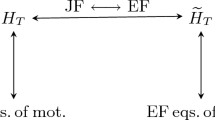Summary
An explicit construction is given of some classes of Hamiltonians invariant under the Poincaré group and describing the evolution of relativistic dynamical systems composed of a single free point, of a point in external fields or of two interacting points. The no-interaction theorem is circumvented by making a clear distinction between evolution parameter and time co-ordinates of each point. The way to introduce the interaction potentials is suggested by the forms of the Hamiltonians of a single point in the different external fields. The possibility of completely using the symplectic structure of the Hamiltonian mechanics allows a classification of the interactions according to which characteristics of the Poincaré groups associated to each particle are conserved by the interaction itself. Various models are thus obtained including, as particular cases, interesting results as the «relativistic rigid rotator» and some generalizations of the classical mechanics with a correct Galileian limit. The equations of motion are analysed in the light of some requirements of physical coherence. Finally the quantization of the most meaningful models is discussed.
Riassunto
Si costruiscono esplicitamente alcune classi di hamiltoniane invarianti di Poincaré che descrivono l'evoluzione di sistemi dinamici relativistici composti da un solo punto sia libero che in campi esterni oppure da due punti interagenti. Il teorema di non interazione è evitato distinguendo accuratamente tra parametro di evoluzione e coordinate temporali dei punti. Il modo di introdurre i potenziali di interazione tra i due punti è suggerito dalla forma delle hamiltoniane di un singolo punto nei diversi campi esterni. La possibilità di usare pienamente la struttura simplettica della meccanica hamiltoniana permette di classificare le interazioni a seconda delle caratteristiche dei gruppi di Poincaré associati ad ogni particella che sono conservate dall'interazione stessa. Si ottengono così vari modelli che contemplano, come casi particolari, risultati interessanti quali il «rotatore rigido relativistico» ed alcune generalizzazioni della meccanica classica con un corretto limite galileiano. Le equazioni del moto sono analizzate alla luce di alcune richieste di coerenza fisica. Si discute infine la quantizzazione dei modelli più significativi.
Similar content being viewed by others
References
R. Giachetti andE. Sorace:Nuovo Cimento A,43, 281 (1978).
D. G. Currie, T. F. Jordan andE. C. G. Sudarshan:Rev. Mod. Phys.,38, 350 (1963);H. Leutweyler:Nuovo Cimento,37, 556 (1965).
A. F. Kracklauer:J. Math. Phys. (N. Y.),17, 693 (1976).
S. Orenstein andK. Rafanelli:Lett. Nuovo Cimento,23, 93 (1978).
A Barducci, L. Lusanna andE. Sorace:Nuovo Cimento B,46, 287 (1978), and references quoted therein. For different approaches see alsoF. Rohrlich:Ann. Phys. (N. Y.),117, 292 (1979);K. Rafanelli andS. Orenstein:An extended particle with interacting constituents.—II: Hamiltonian formulation, preprint, New York, N. Y. (1979);K. Rafanelli andS. Orenstein:Nuovo Cimento A,48, 227 (1978);Ph. Droz-Vincent:Hamiltonian construction of predictive systems, inDifferential Geometry and Relativity, edited byM. Cahen andM. Flato (Dordrecht, 1976).
M. Pauri andG. M. Prosperi:J. Math. Phys. (N. Y.),7, 336 (1966).
E. C. G. Sudarshan andN. Mukunda:Classical Dynamics: a Moden Perspective (New York, N. Y., 1974).
R. Giachetti andE. Sorace:Nuovo Cimento B,45, 130 (1978).
J. M. Souriau:Structure des systèmes dynamiques (Paris, 1970).
This reduction method can be applied in the same way to any set of canonical variables, as the «global and relative» ones defined in sect.5.
F. Gantmacher:Lectures in Analytical Mechanics (Moscow, 1970).
We use the metricg μν=diag (+1, −1, −1, −1) and we adopt the convention of summing over repeated tensor indices.
D. Dominici, J. Gomis andG. Longhi:Nuovo Cimento B,48, 152 (1978).
For instance, this happens whenever the canonical equations imply two or more identities involving the velocities. A typical case is (q i)2)=1,i=1,n.
R. D. Driver:Ordinary and Delay Differential Equations (New York, N. Y., 1977).
M. Le Bellac andL. M. Lévy Leblond:Nuovo Cimento B,14, 217 (1973).
R. Giachetti andE. Sorace:Lett. Nuovo Cimento,26, 1 (1979).
The above discussion closely parallels results so far obtained within the framework of general relativity. See, for instance,L. Landau andE. Lifchitz:Théorie des champs, sect.84 (Moscou, 1970);C. Cattaneo:Nuovo Cimento,10, 318 (1958);R. Goldoni:Gen. Rel. Grav.,6, 103 (1975).
D. Dominici, J. Gomis andG. Longhi:Nuovo Cimento A,48, 257 (1978).
G. E. Chilov:Analyse mathématique. Functions de plusieures variables réelles (Moscou, 1975).
Pham Mau Quan:Introduction à la géométrie des variétés différentiables (Paris, 1969).
The factor in front ofV may be substituted by any other symmetric expression inp and π whose classical limit is twice the reduced mass.
E. C. Zeeman:J. Math. Phys. (N. Y.),5, 490 (1964).
To realize the mathematical problems connected with the existence of relativistic wave operators, seeL. P. Horwitz andA. Soffer:On the existence of the wave operators in relativistic quantum scattering theory, preprint, Tel Aviv, TAUP 735-79.
We use units with ħ=1.
K. B. Wolf:The Heisenberg-Weyl ring in quantum mechanics, inGroup Theory and Its Applications, edited byE. Loebl (New York, N. Y., 1975);L. Castellani, D. Dominici andG. Longhi:Nuovo Cimento A,48, 91 (1978).
It is remarkable that eqs. (11.13) are very close to those obtained in ref. (19). by means of a singular Lagrangian approach: the difference arises from the factor we introduced in (9.11) just to recover the correct Galileian limit. If this factor is set equal to unity, then the first of (11.13) is identical to (5.2) of ref. (19),D. Dominici, J. Gomis andG. Longhi:Nuovo Cimento A,48, 257 (1978).
Y. S. Kim andM. E. Noz:Phys. Rev. D,8, 3521 (1973).
H. Haken:Synergetics (Berlin, 1977).
P. Gerber:Z. Math. Phys.,43, 93 (1898). We found the quotation of this paper inE. Mach:Die Mechanik in ihrer Entwicklung historisch-kritisch dargestellt (Leipzig, 1901).
Author information
Authors and Affiliations
Rights and permissions
About this article
Cite this article
Giachetti, R., Sorace, E. Relativistic two-body interactions: a Hamiltonian formulation. Nuov Cim B 56, 263–301 (1980). https://doi.org/10.1007/BF02729264
Received:
Revised:
Published:
Issue Date:
DOI: https://doi.org/10.1007/BF02729264



